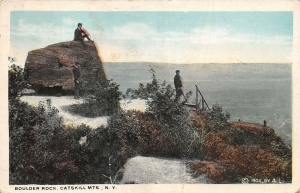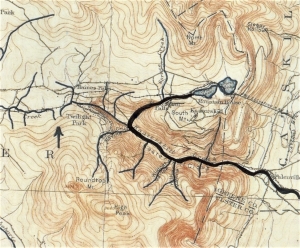The Heart of Darkness (in the Catskills)
The Heart of Darkness
The Kaatskill Geologist
Kaatskill Life – Fall 2004
Updated by Robert and Johanna Titus
There is, if you can imagine it, a “darkest Catskills,” a place where Nature still truly prevails. It is a wholly untamed wilderness where, even in our time, people are sometimes afraid to tread. Once you have entered it, it becomes a place that seems to draw you on but, no matter how deeply you go into it, and no matter how difficult your trek has become, it will only get worse. Still, it is a place that teases you on with promises of natural beauty that numbs your normal cautions. It is a dangerous place, but, in the end, it is worth the risks; it is one of the most beautiful localities in all of our mountains and that is saying a lot. But you always have to remember that one thing: no matter how difficult it is, it will only get worse. It is the canyon of Plattekill Clove.
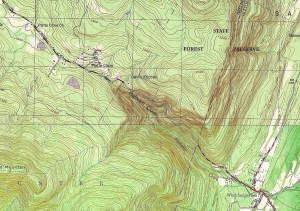
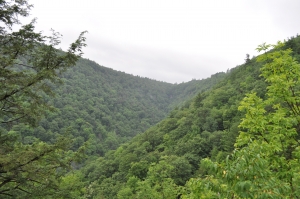
You can never think about Plattekill Clove without comparing it to its big brother – Kaaterskill Clove. Each is a very large, deep ravine cut into the “Wall of Manitou:” that great ledge we call the Catskill Front. Kaaterskill Clove is longer
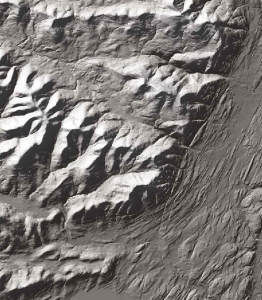
and deeper, and it is a rugged and majestic place. And Kaaterskill Clove also seems to be an older geological feature. It may well be more than 100,000 years old and, in that time, it has been able to carve a canyon bottom that rises relatively smoothly from the Hudson River lowlands to Haines Falls. Plattekill is shorter and not quite as deep, but it is fundamentally different; here erosion has had time to create waterfalls, but not the time to destroy them. This whitewater stream, as it descends its canyon pauses at each sandstone ledge. Often it has created deceptively pretty little pools of water and then tumbled over the edge of the cliff to make a powerful waterfall. There is a geological irony here. The sandstone ledges that cap our modern falls are the lithified sediments of Devonian age rivers. The sands of ancient rivers block the flow of modern creeks.
Thus, it is that stratigraphy has given the Catskill Front a series of very rugged ledges, and, at Plattekill, each one of them has its own waterfalls. Back at the older Kaaterskill Clove the creek there has had time to erode its way through most of those ledges and only a few falls remain. Kaaterskill Clove is like a deep old wound that has had enough time to do some healing. Plattekill is more like a fresh stab. Both are rugged, both are beautiful, but Plattekill is more jagged and raw. Nature has done no healing in this canyon.
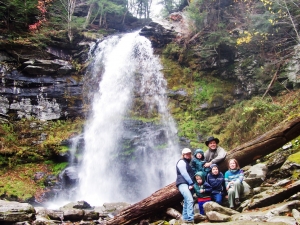
We have written about Plattekill Clove before (Kaatskill Life, spring, 1999), but only about the clove as it can be seen from the many wonderful scenic vantage points looming above it. There is a whole different clove, and that is the one that you can only see from down below. It can be, quite literally, the heart of darkness. On an overcast day, as you ascend this canyon and the walls rise above you, it actually gets dark.
It once was a popular tourist attraction, and back in the late 19th century there were several hotels here. Many old postcards date back to then, but those times are long gone. Today, not many people hike the great canyon. It is a very rough place and there are no marked trails; it is no place for the novice hiker. And it is not a very easy place for the advanced hiker either. We, and some of the best hikers that we know, have actually confessed to have been intimidated by its reputation. But the canyon does beckon and one August day four of us decided to give it a try.
The lower canyon is a deception; it seems to be there with the purpose of luring you on. It’s picturesque but surprisingly easy to hike. The end of the last ice age gave this part of the clove a deep blanket of soft sediment, something we call an alluvial fan of sand and gravel (Kaatskill Life, spring, 2002). The post ice age flow of water cut through those gravels and created a beautiful ravine. You can follow an easy unmarked trail along the rim of that ravine and gaze down into the rugged stream below and enjoy the walk immensely. But remember, this is Plattekill; it only gets worse ahead.
As we said, there are many waterfalls in Plattekill; it’s not easy to count them, but traditionally the number is 17. We reached our first and it was a beauty. Among the nicest things about the falls of Plattekill are the “plunge pools” that form beneath them. Over the millennia, high flows of water have tumbled over the falls and carved out deep pools at their bases. These form very fine swimming holes which are real attractions. We found the messy evidence of much swimming and picnicking and general partying at the base of our first fall. But we had no time for any of this ourselves; we followed an easy trail up and over the falls and pushed on. Now we were really in the wilderness that makes up Plattekill Clove.
Soon we saw the first of many unusual boulders of the trek; it was large, five feet across, well weathered and nicely rounded. We looked it over carefully and found it to be a “foreigner.” It was not composed of Catskill bluestone as it should have been. Instead, it was a rock called gneiss. Gneiss is a metamorphic rock, which means it formed under very high temperatures and pressures; this one had formed in the Adirondacks or New England, and it had been brought down the Hudson Valley and left here by the glaciers. We would look for and find quite a few others during the rest of the day. They spoke to us of the ice age glacier that had preceded us here. Maybe fourteen thousand years ago a tongue of ice had climbed the clove, all the way to the top. It had carried boulders with it and left them here when the climate warmed. Now those boulders were slowly traveling back down the clove. Plattekill tells a lot of stories when you look into its rocks. We pushed on.
At two hours into our ascent, we passed a small tributary stream coming in from the right and then, very soon, another one on the left. These were what geologists call “parallel streams.” They plunge down very steep slopes and are, all of them, nearly vertical, they are almost as much waterfalls as they are streams. Vertical streams are, of course, all parallel and hence the term. Our second one has had a number of names: it has been called “Black Chasm Creek,” and “Coal Kiln Creek,” and “Cold Kill Creek,” and “Cross Clove Creek.” The name doesn’t matter much, but we would not soon forget this little stream. On this day there was very little water in it, but there were a very large number of very big bluestone boulders (fig. 5). Such steep streams can transport very large boulders with little difficulty; they get a large boost from gravity. For millennia, both of these streams had been funneling these great rocks out of the highlands above. This journey was not a very long one, but it was a very slow one. These rocks will be tumbling for many more thousands of years. Plattekill is like some sort of reverse Diogenes, it seems to be forever rolling rocks down the hill.
The idea that there can be streams of boulders was not new to us, but we were most impressed to see this one. We continued up the main canyon and in a hundred yards or so we encountered another stream of boulders, this one being in Plattekill Creek itself. There were hundreds of them, and many were more than ten feet across. We wondered how much they weighed. We had not much noticed it, but Plattekill had slowly become a steeper canyon. Its slope was great enough so that it too was transporting the heavy weight of big boulders. We had seen Plattekill Clove as a fresh wound into the Catskill Front. Now the metaphor was working very well. Our Catskill wound was now bleeding streams of boulders.
Next, we entered into what seemed like a whole new realm of Plattekill. Slowly, we found our attentions drawn upwards, as great vertical cliffs of sandstone came to tower above. And tower is just the right word; those walls were sheer cliffs – left and right -rising what seemed to be a hundred feet or more. At the same time, the canyon seemed to narrow, and we found ourselves being funneled into a tighter squeeze. Here, we saw no more boulders, instead the centuries of intense spring floods had flushed this part of the chasm clear. On this August day, the flow was very low, but the months of March and April must have witnessed a far more powerful flume of meltwater. We didn’t like to think about the angry gray flows of that season. There are some things that humans should not go and see, and this was one of them. We pushed on clambering up the steep and often slippery bare red bedrock. The clouds rolled in high above and now the light in the deep canyon began to dim; we were truly in the heart of darkness.
But you must always remember: no matter how difficult Plattekill Clove is, it only gets worse. Now, after four hours of serious hiking, we found ourselves at the base of Green Falls, perhaps the tallest waterfalls of Plattekill Clove. Much to our dismay, these falls were a shear cliff and offered no hope of being climbed. The thought of turning back was too dismaying. But none of us had been here before and it seemed that there was no way to go on. Only to our left, however, there was there any glimmer of hope for completing our ascent; there lay the now dry channel of another stream of boulders. It was either climb this or turn tail and retreat down the canyon. We began what would be an arduous ascent; it is a 270 foot upward climb over a chaos of rough, angular boulders. We made it, but it took quite a while, and the reward was further disappointment. There at the top of our hard scramble was still another impediment.
Before us was another 20-foot-thick ledge of sandstone, we had seen so many already on this day, but this one seemed of offer no way at all to pass up and over it. In Plattekill, it only gets worse. Once again, we faced the irony of being blocked by a nearly 400-million-year-old, Devonian stream channel as we tried to ascend a modern creek. We explored to our left and to our right and found nothing but that vertical sandstone citadel. Now, it was getting late: should we climb all the way back down the Clove, a five-hour retreat that might carry us into true nighttime darkness? Or should we press on in search of an escape route over this ledge? This was a difficult moment.
Well, all turned out, we explored farther to the right and found a dead tree lying against our ledge. It didn’t have many branches left, but there were just enough to make an “Indian ladder” out of it. We pushed and pulled each other up the ladder and soon found a flat trail to the base of Plattekill Falls and the trail out of the upper clove. Our moods improved greatly.
Before breaking up, our little group climbed out to the overlook above the Devil’s Kitchen and there we saw the solution to the biggest mystery of the day. Why did Plattekill Clove persist in getting steeper and rougher as we climbed to its top? In an instant we saw the answer. At the Devil’s Kitchen we saw that the sandstones here are broken by fractures of the sort that geologists call “joints.” Joints are smooth flat fractures of the rocks. They are like faults, except that there has been no motion of the rocks on either side. Here, as is always the case, the joints are closely spaced and, those of Plattekill Clove, cross the clove
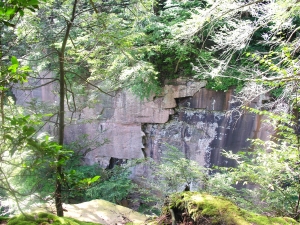
along a northeast to southwest compass direction. That means that as large masses of rock break loose and fall, they leave vertical walls that loom above the head of the clove. The fracturing was concentrated in the upper reaches of the clove, and this had accounted for the ever-increasing steepness. The broken joints had also, no doubt, provided the bulk of the boulders that we had been seeing all day long. Our conquest was now complete; not only had we climbed Plattekill Clove, but also, we had solved one of its best geologic mysteries.
After our long and strenuous day, our companions were happy to disperse and return to their homes. We, however, had a special privilege: the Catskill Center for Conservation and Development had loaned us their little red cabin for the night. That’s the one at the top of Plattekill Falls. We would spend a very nice evening on its porch listening to the roar of the water passing into the great clove that was now, happily, beneath us.
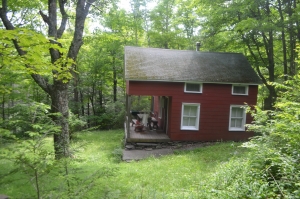
Late in the evening, more clouds rolled in, and all around us it became very dark. The air was still, and the summer insects were very loud. From high up above, on Plattekill Mountain, came the cry of a single coyote. It was quickly joined by the howls of a whole pack of them. We are told that they do this after making a kill. This is a wild place.
Contact the authors at randjtitus@prodigy.net. Join their facebook page “The Catskill Geologist.”

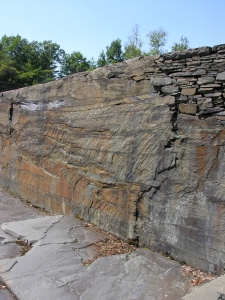
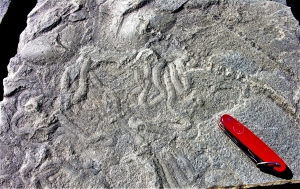
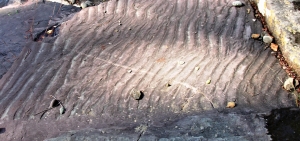
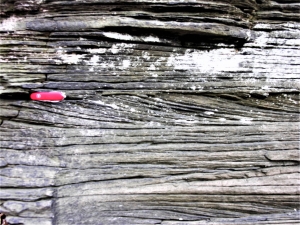
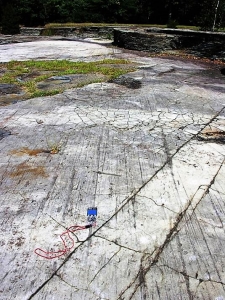
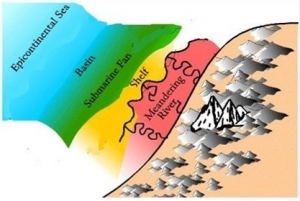
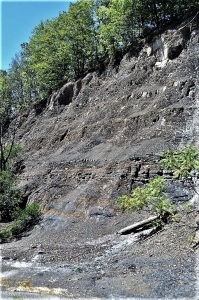
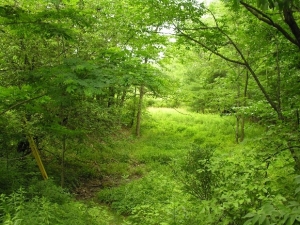
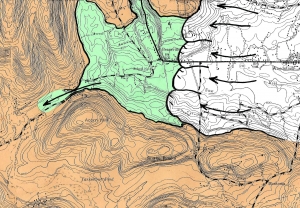

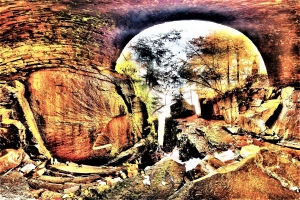
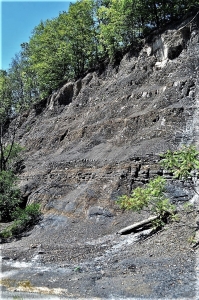 t it occasionally in Woodstock Times columns over the years. The unit of rock has recently become very important.
t it occasionally in Woodstock Times columns over the years. The unit of rock has recently become very important.